国际商务谈判英文版最新版教学课件第2章
第二章 谈判准备 《国际商务谈判》PPT课件

Prioritizing One’s Goals
• Three levels of goals
– Ideal target – Minimum target – Realistic target
Defining one’s interest
• Substantive interest • Process-based interest • Relationship-based interest
• Discover advantages and disadvantages of the team
• Determine the order of negotiation • Analyze what sticky problems might
appear • Work out measures to deal with them
Roles of Negotiation Information
• As the basis for working out strategic plans • As a means to control the negotiation process • As the medium between the two parties
Information on Related Environmental Factors
• The Political State • The legal System • Religious Beliefs • Business Conventions • Financial State • Social Customs • Infrastructure and Logistics System • Climate factor
国际商务谈判英文版最新版教学课件第2章

• Self-assessment • Assessment of the counterparty • Assessment of the situation
批注本地保存成功开通会员云端永久保存去开通
2-1
Part One The Essentials of Negotiation
— Chapter 2 — Preparation:
What to Do Before Negotiation
2-2
The Fixed-Pie Perception
Most negotiators believe whatever is good for one party must be bad for the counterparty.
People with this fixed-pie perception take one of three mindsets when preparing for a negotiation:
• Resign themselves to capitulating to the counterparty
2-11
Self-Assessment: Endowment Effects
Differences in negotiators’ reference points may lead buyers and sellers to have different valuations for the same object
• Brainstorm your alternatives. • Evaluate and order each alternative’s value. • Attempt to improve your BATNA. • Determine your reservation price based on facts. • See Exhibit 2-1.
国际商务谈判(第二版)unit02makeanoffer

价格谈判
1 2
价格调整
在谈判过程中,可以根据客户的反馈和需求,适 当调整价格。
附加条件
除了价格本身,还可以通过附加条件来争取更好 的谈判结果。
3
谈判底线
明确自己的谈判底线,不要轻易让步,同时也要 了解客户的底线。
达成协议
合同签订
在达成协议后,需要签订书面合同,确保双方 的权益得到保障。
后续跟进
协议签订后,需要跟进客户的需求和反馈,确 保合作顺利进行。
02
提出报价前的准备
市场调研
了解市场需求
通过市场调研,了解目标市场的需求、消费者偏好以 及潜在的竞争对手情况。
分析市场规模
评估市场规模和增长潜力,以便预测未来的市场趋势。
确定目标市场
根据市场调研结果,确定产品或服务的目标市场,并 制定相应的营销策略。
产品定位
明确产品特点
01
了解产品或服务的独特卖点,以及与竞争对手的差异。
文化差异影响
国际商务谈判中,文化差 异对谈判结果产生重要影 响,需要充分了解和尊重 对方文化。
谈判目标
达成合作协议
通过谈判,双方就合作事 宜达成一致意见,签订合 同或协议。
实现利益最大化
在谈判中争取自身利益的 最大化,同时也要考虑对 方的利益诉求。
建立长期合作关系
通过谈判,建立互信和良 好的合作关系,为未来的 合作打下基础。
报价方式
直接报价
直接列出产品或服务的价格,简单明了。
对比报价
通过对比其他产品或服务的价格来突出自己产品的优势。
分解报价
格构成。
报价技巧
高开低走
报价时先报一个较高的价格,然后逐渐降低价格,以吸引客户。
商务英语谈判lecture 2.ppt
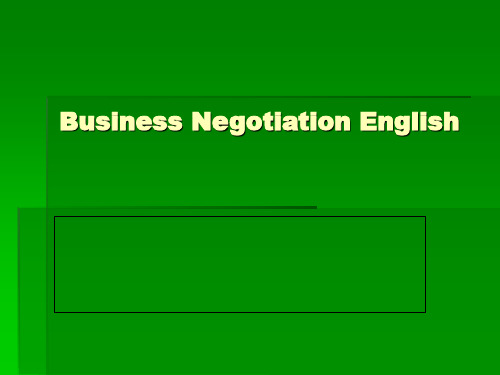
。2020年12月10日星期四2020/12/102020/12/102020/12/10
▪ 15、会当凌绝顶,一览众山小。2020年12月2020/12/102020/12/102020/12/1012/10/2020
▪ 16、如果一个人不知道他要驶向哪头,那么任何风都不是顺风。2020/12/102020/12/10December 10, 2020
▪ 9、春去春又回,新桃换旧符。在那桃花盛开的地方,在这醉人芬芳的季节,愿你生活像春天一样阳光,心情像桃花一样美丽,日子像桃子一样甜蜜。 2020/12/102020/12/10Thursday, December 10, 2020
▪ 10、人的志向通常和他们的能力成正比例。2020/12/102020/12/102020/12/1012/10/2020 7:55:00 PM ▪ 11、夫学须志也,才须学也,非学无以广才,非志无以成学。2020/12/102020/12/102020/12/10Dec-2010-Dec-20 ▪ 12、越是无能的人,越喜欢挑剔别人的错儿。2020/12/102020/12/102020/12/10Thursday, December 10, 2020 ▪ 13、志不立,天下无可成之事。2020/12/102020/12/102020/12/102020/12/1012/10/2020
Solution:
But an interest-oriented examination of the dispute leads to the question: How can the higher cost of manufacturing four models be allocated between the American importer and the Chinese manufacturer? In this example, the parties were able to devise a formula that increased the unit cost of different models to reflect the Chinese manufacturer’s increased manufacturing cost.
国际商务谈判(英文) 全套课件-PPT资料238页
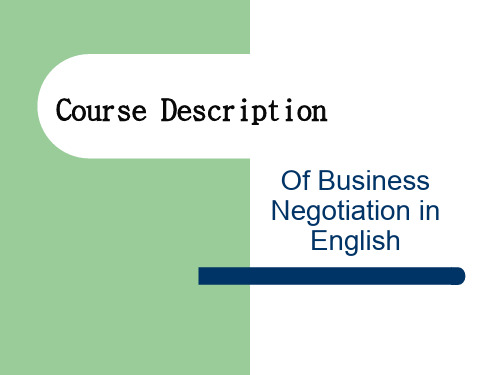
考核方式
商务谈判口语是一门专门用途口语课程,因此考 试形式为团队对抗模拟谈判的口语考试。从一开 始明确考核的方式是团队考核,每个成员要发挥 作用,否则影响团队分数。在学期初形成固定的 谈判代表队, 最后用抽签的方法决定最后的谈 判模拟中哪一队和哪一队进行谈判。
Unit 1 Making an Enquiry
3.What do you usually ask for in the enquiries?
Catalogue,sample,price-list,quotation,terms of payment, date of delivery,etc
4.How do you invite a best possible price in an enquiry?
Teacher-centered
Explanation of language expressions, special terms, negotiation skills and concerned knowledge
Student-centered
Practice in the situation offered in groups
3. Three Steps to Follow :
Different items and situations demand different skills, generally you have to follow three steps:
1)devise a target 2) do some preparations 3) negotiate for the target
国际商务谈判英文 chapter2
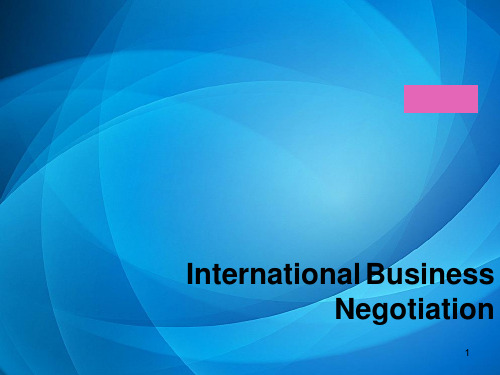
1
Chapter2 • Need Theory ng Objectives
After studying this module, you should be able to know:
10
• 2.2.2Strategy for the classic prisoners' dilemma
• The best deterministic strategy was found to be tit for tat, which Anatol Rapoport developed and entered into the tournament .
7
• 2.1.2the need theory and negotiation • (1)Survival needs and negotiation • (2)Security needs and negotiation • (3)Social needs and negotiation • (4)Ego needs and negotiation • (5)Self- a c t u a l i z a t i o n needs and
• 1.What is need theory? • 2.How to apply need theory to international
business negotiation? • 3.Game theory and negotiation
3
Contents
1
Need theory
2
Game theory
9
2.2 Game Theory
• 2.2.1 The prisoner's dilemma
国际商务谈判,课件,Unit 2

Unit two Setting the Agenda
• 谈判议程(agenda)也就是谈判的程序,包括所谈 事项的次序和主要策略。再拟定谈判议程时要注意 两点: • 一是议程的互利性,即不仅要符合己方的需要,也 要兼顾对方的利益和习惯做法; • 二是议程的简洁性。典型的谈判议程至少包括这样 三项内容: • 1. 谈判何时举行?谈判为期多久?如是一系列谈判, 则分几次进行?每次时间多长? • 2. 谈判在何地举行? • 3. 哪些事项应列入讨论?如何排序?每一事项应占 多长时间?
Unit two Setting the Agenda
5.Watch Version 2. How does Francoise control this opening phase?
Байду номын сангаас
Francoise keeps total control over the opening phase. She has clearly prepared well and knows where she is going.
Unit two Setting the Agenda
4. Watch Version 1. Do you think it’s a good idea to raise the critical issue so early in the negotiation? How would you handle the aggressive position immediately adopted by Sean? Most negotiators start by identifying the common ground. In other words, the points which both sides agree on. Then you have a firm basis to discuss problem areas. It is important that the Okus team do not show too strong an emotional response to Sean’s aggression. Sean will see this as a weakness.
全套课件 国际商务谈判(英文版)
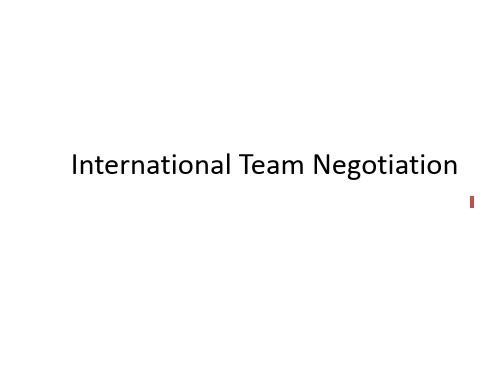
• COMMENCE ROLE PLAY • FINISH ROLE PLAY • GIVING ASSESSMENTS OF NEGOTIATION SKILL
国际商务谈判第二版Effective negotiator
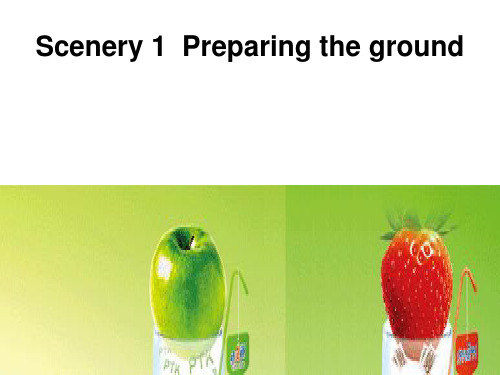
Scenery 2 Setting the agenda
2. Background information
(1) The people Andrew Carter : is Export Sales Manager for Okus IT. He is ready to make his opening presentation. Karen Black: is a Project Manager at Okus IT. She is expecting Francoise to set out the agenda for the meeting. Francoise Quantin: is the current IT Manager at Levin. She is very anxious about protecting the jobs of her IT team. Sean Morrissey: is from Levien’s Chicago office. He wants to establish a clear and strong position for Levien.
Francoise: There’s no need to hurry. Karen? Sean: Andrew, you’ll have another one? Andrew: Please. Milk, three sugars. Francoise : Sit down, please. Andrew: Are you missing the States, Sean? Sean : Yeah, I’m missing the kids and my wife. Andrew and I negotiated a deal in Dallas two years ago. Andrew: Yes, quite a marathon—thirty-six hours, wasn’t it? Sean : Andrew, if a job’s worth doing, it’s worth doing well. Francoise : Perhaps we had better start now. (Over)
国际商务谈判(英文版)(doc 10页)

国际商务谈判(英文版)(doc 10页)封面Fashion creative companyname作者:日期:邮箱:2Business Negotiation – Lesson 2 Chapter 1Slide 1One of the most important things to remember in business is to never make enemies. You don’t have to love everyone, but if you dislike someone make sure you don’t show it. Your enemy today may be your boss tomorrow.Slide 2The basic principles of negotiation are:- communication, negotiable issues, common interests, give and take, trust and to be a good listener.Slide 3The most successful negotiation ends with a win-win solution. Both parties must feel as though they have gained something. Both parties must negotiate towards a mutual gain.Slide 4Before negotiations begin, both parties should know the following six details:- why, who with, what, where, when and how they negotiate. Slide 5Negotiation is a process of exchanging information between two sides and both sides try to understand each other’s points of view. Both parties know that they have common and conflicting objectives, so they try to find a way to achieve a common and helpful objective that will be acceptable to them both.Slide 6In summary: common interests must be sought. Negotiation is not a game. In a successful negotiation, everyone wins something.Slide 7Succ ess isn’t winning everything –it’s winning enough. Slide 8In negotiation, both equality and mutual benefit are very important. Both parties are equal in status. They have equal rights and obligations. Remember that in a successful negotiation, each party must gain something or there is no reason for the other party to participate. Both parties should prepare well for the negotiation and be ready to satisfy the other party’s needs on an equal basis.Slide 9Through negotiation, both parties are seeking an arrangement of a business situation. The purpose of this is to seek a win-win situation instead of a win-lose one. It is through sincere cooperation that this result can be made.Slide 10Sincerity is very important for a negotiator’s style. Develop trust between the two parties. Treat others as you want to be treated, this will promote the negotiation and get successful results.Slide 11 Keep it flexible and fluid. Do not be too rigid in what you want to give, and in what you want to take. All negotiations are a process of constant thinking, exchanging information and continuous giving. Before negotiation try and work out what the other party might be thinking, what their needs may be and what their tactics might be.Slide 12 During negotiation, it is very easy for conflicts to happen. It may be that one side wants to take more than what they give. When this happens, either side may break out of the relationship. Thisis a lose-lose situation. It is in both parties interests to find ways to minimize their conflict to achieve a win-win situation.Slide 13 Most business negotiations take place between suppliers and purchasers (sellers and buyers).A supplier cannot exist unless he has a purchaser.Slide 14 Of course in negotiations both parties want to give as little as possible, and to take as much as possible, gaining as much profit as possible in the process. So during negotiations both parties usually give only a little at a time.Slide 15 Both parties must be flexible and make changes during negotiation as required by the situation.Slide 16 Negotiators need to be cooperative and dedicated, to find the best solution possible, insteadof just being concerned with their own needs.Slide 17 In negotiation, both sides must try to reach an agreement that maximizes their own outcome. This may lead either side to be concerned only with their own gain and ignore the needs of the other party. Remember that most business relationships last for a long period of time, so it is beneficial for both parties to gain a win-win situation and continue the business relationship.Slide 18 The three stages of negotiation are:-pre-negotiation, during negotiation andpost-negotiation.Slide 19 The pre-negotiation stage begins from the first contact between the two sides. This is when they show interest in doing business with each other. During this stage the gathering of information will determine the success or failure of the negotiation. The information to be gathered by either party should include:- the market, policies, regulations and financial background.Slide 20 The second stage of negotiation (during negotiation) has five phases through which it must proceed. They are:- exploration (finding out what the other party want), bidding (giving), bargaining, agreeing and making it official (contract).Slide 21 The third stage is post-negotiation. At this stage, all the terms have been agreed upon and the contract is being drawn up, ready to be signed.Business Negotiation – Lesson 4 Chapter 2Slide 1Title page - Today we are working on chapter 2.Slide 2Proper Behaviour in Business Negotiation. People always make assumptions before negotiation and try to guess what the other party are assuming. Assumptions may be true or false, they need to be verified. Listening, talking, inquiring and observing are very important for a successful negotiation.Slide 3Hidden Assumptions. We sometimes place ourselves at a great disadvantage with hidden assumptions about what other people’s motivati ons and actions might be. Don’t assume you know everything about your opponents.Slide 4Listening. Listening carefully to the words spoken by the other party is very important. You must understand what the needs of the other party are. Paying attention to phrasing (the vocabulary they use), their choice of expressions, the mannerisms of speech and the tone of voice they are using. All of these elements give you clues to the needs of what the other party wants.Slide 5The barrier of listening. Some topics are rather difficult and hard to comprehend, do not get distracted, stay focussed. If necessary ask the speaker to repeat something that you have missed or do not fully understand. When you are taking notes, concentrate on the concepts and principles first and then if you have time, write down the facts.Slide 6Active listening. When someone is making a point or presenting an opinion, do not interrupt until they have finished speaking. Then you can ask them to repeat any parts that you didn’t understand.Slide 7Negotiation language. You should only communicate the points needed, to encourage the action your party desires.Your party should be informative, to support only the details necessary to make your offer clear. Keep your sentences simple. Your presentation should be fair and consider both the pros and the cons. Your presentation should be cooperative and friendly, not argumentative or hostile. It should emphasize the positive points, not the negative points.Slide 8Aspects to be aware of. Listeners judge you by how you talk. Your speaking voice is one of the first impressions people have of you. A person may be characterized as friendly if his or her voice sounds warm and well modulated. If someone has a flat monotonous voice they will be judged as dull and boring. Do not talk too fast or you will give the impression that you are nervous and not confident. Slide 9Asking questions. In an appropriate situation you should ask the other party “What do you want from this negotiation? What are your expectations? What would you like to accomplish?” Be quiet after asking a question, encourage others to talk as much as possible so youcan gain more information. When you ask questions, make sure you listen to the answers.Slide 10Answering questions. Always give yourself time to think about the question being asked. Never answer until you clearly understand what is being asked. Do not be embarrassed to ask them to explain the meaning of their question. Before negotiations begin, anticipate what questions may be asked, so that you can plan your answers before the negotiation.Slide 11Observing. Besides listening to the other party in an attempt to learn their desires and needs, you must also closely observe their gestures. Body language and gestures are very important. Our entire bodies, including our head, arms, hands, fingers and even our posture can convey a message. Slide 12Eye contact. A person who looks away a lot while listening to you is showing that they are not happy with with you or what you are saying.Slide 13 The mouth. When you meet or greet someone, you should do so with a warm, genuine smile.Slide 14Hands. What you do with your hands is a very significant form of body language. Your handshake reveals clues to what you really think of someone. A firm handshake gives the impression of confidence and seriousness. The weak handshake has no energy at all and suggests a lack of confidence, interest and warmth. If the other party puts both of his/her hands on the table and he/she leans forward, it means they are confident and ready to get down to business.Slide 15 The nose. Touching the nose or slowly rubbing it usually means someone has doubt in what they are saying and maybe it could indicate that this person is lying.Slide 16 The legs. A person whose legs are crossed, and who is leaning away from you is probably very competitive. If someone has their legs crossed and their arms crossed they will be difficult opponent.If the person has their legs crossed and they are swinging the top leg it means that they are probably bored with your ideas and opinions. If someone likes you or your ideas they will lean forward slightly in a relaxed manner with a slightly curved back.Slide 17 The Feet. A person whose toes are turned towards each other (pigeon toed) or tucked under the chair is very timid or scared.Business Negotiation – Lesson 6 Chapter 4Slide 1 Title Page– Today we will work on chapter 4.Slide 2Preparing for Negotiation. A successful negotiation is determined by its preparation. Thinking beforehand about who you are going to meet, what is going to be discussed, and what will be the best approach is very important. Good preparation has an impact on the opening stages of a negotiation, which sets the tone for the rest of the meetings.Slide 3Scheduling the first meetings. The first impression each side makes will most likely have a major effect on the style, progress and eventual outcome of the negotiations. Scheduling the first round of meetings is an important task for both sides and should be handled in a manner that preserves the professionalism of all the attendees. Arrive to the meeting promptly and be prepared to get right to work.Slide 4Setting the agenda. From a communication point of view, the process of structuring and controlling a negotiation focuses on the importance of setting an agenda and a procedure for the meeting. The agenda includes the order of the issues to negotiate and its main negotiation methods like what to negotiate first, what others to negotiate later and what is the final goal to attain etc. Slide 5Negotiating Agenda. An agenda pay be presented by one side or prepared by both parties, or each side may prepare a general agenda and a detailed agenda. The general agenda is presented to the other side, and the detailed agenda is for your own use. Attention should be given to the various issues to be discussed so that strategies can be developed. The issues might be listed so that the major ones are discussed first. This will prevent wasting time on minor issues and to make sure of leaving sufficient time to discuss the major ones.Slide 6Preparing for negotiation. Do your homework. Successful negotiation results are directly related to its smooth implementation and will bring enormous results.Slide 7Establishing Objectives. The objective is the prerequisite of a negotiation. Under the guidance of clear, specific, impersonal and feasible objectives could the negotiation be in a positive position.Key elements of negotiation objectives are:-Who can contribute to this negotiation, who will be affected by this negotiation, what are the maximum and minimum targets to seek. Minimum targets means the targets or benefits we would never give up, in other words there is no room for bargaining. Maximum targets are the targets or benefits we could think of giving up under critical conditions.Slide 8Key elements of negotiation objectives (cont.) When would we like to conclude the negotiation, where is the best place for the negotiation, why has the other party chosen us to negotiate with, what concessions are we willing to make and what concessions will the other party be likely to make.Making the objective of a negotiation rigid might cause the negotiation to breakdown. An alternative method of formulating objectives might be to keep them fluid so that the expectations can change with the circumstances of the negotiation.Slide 9Issues and positions. Any information upon which there is disagreement can be organised into the negotiation issues. Issues are the things on which one side takes an affirmative position and the other side takes a negative position. Issues should be realistic. It is important that we should try to negotiate problems rather than our demands. Our demands are only a one-solution approach to the problems. There may be other solutions. It is said that your bargaining position should conceal (hide) as well as reveal (show), and as negotiations continue, concessions alternate from each side.Slide 10Meeting places. Should you conduct the negotiation in your office, or should you go to the other party’s home ground? The general rule is that you perform better on your own home ground. A negotiator on home ground is more assertive and more confident. In contrast a negotiator that is a guest on the other party’s home ground may feel subordinate. The fairest for both parties is to meet on neutral territory where no one will have the psychological edge.Slide 11Opening the meeting. Good negotiating atmosphere is better to be formed at the very beginning of the negotiations. Therefore, both parties should seize the occasion of the first meeting when doing self-introduction or being introduced. Try to behave gracefully and speak clearly to make the impression of being kind, natural and honest. Exercises from bookBusiness Negotiation – Lesson 9 Chapter 5Slide 1Title Page – Chapter 5Slide 2The Bargaining Process.The pattern of bidding and bargaining is seen by many people to be the core of the negotiation process. Almost all the negotiations have something to do with bidding and bargaining. The bargaining process is normally very intense. Both sides are trying to move to their own advantage. Or if it is not possible to cut the cake so that both parties get what they want, then they bargain in such a way that the dissatisfaction will be equally shared between them.Slide 3Bidding.The opening bid (price) needs to be ‘the highest’ because:- our first bid influences others in their valuation of our offer, a high bid gives room for manoeuvre during the later bargaining stages, the opening bid has a real influence on the final settlement level. The more we ask, the more we will achieve.Slide 4Bidding (cont.). You must be able to justify your original bid, you should not only seek to gain as much as possible but you also take the other party into consideration. Putting forward a bid that unrealistic and cannot be defended will damage the negotiation process. If we cannot defend our bid when challenged we will lose face and credibility. Slide 5The Highest Realistic Bid. The highest defensible bid is not set in concrete. It is a figure that is relevant to the particular circumstances. If the opposing party is pushing for their advantage, then for our advantage we must push for the highest price. If we have a lot of competition, we musttailor our opening bid to the level at which it at least enables us to be invited to continue negotiations. Slide 6Content of Bid. The content of the bid usually needs to cover a range of issues:- the price, how badly the product is needed, the amount of product needed, product credibility, credit terms (payment of goods), competition in the market. The parts of the opening bid in a commercial negotiation will not only be price, but a combination of :- price, delivery, payment terms, quality specification etc.Slide 7Presentation Tactics. In the bidding presentation of the negotiation process, there are three guidelines to the way in which a bid should be presented:- firmly, clearly and without comment. The bid should be put firmly, seriously and without hesitations. It needs to be understood clearly so that the other party recognises precisely what is being asked. In the process of negotiation, it’s better to have the quotation typed on paper, to ensure the clarity of the bid and to show the other party a sense of seriousness and legitimation.Slide 8Responding Tactics. Both sides at this time are trying to move the negotiation to a more favourable direction to their own side. It’s quite necessary to do some homework, researching the other side before responding to the bid.The competent negotiator should make sure they understand what the other party is bidding, should have an idea how to satisfy the other party and at the same time try and figure out what the other party’s expectations are. The competent negotiator should summarise his/her understanding of the bid as a check on the effectiveness of communication between the two parties.Slide 9Bargaining. In this stage of the negotiation it is very important not to give the other party too much too soon. Bargaining should be to your advantage, however you must also make a fair deal in which both parties are equally satisfied or equally dissatisfied.Slide 10Bargaining Moves. As we start the bargaining process we need to take two steps:- get it clear, assess the situation. It is vital to establish a clear picture of the other party’s requi rements at the beginning. You must have a clear picture of what the other party is bidding already. Your main concern is to understand what bid is being offered. Slide 11Clarification of Opposers Bid. Check every item of the other party’s bid. Inquir e the reason and bases of the bid, ask how important the item is and how much flexibility is in the bid. Pay attention to the other party’s explanation and response. Listen to the other party’s answers without comment and reserve your opinion.Slide 12Clarification of your Bid. Try not to divulge too much information and knowledge, keep things simple. Give only the essentials asked for, do not go into lengthy comments or justifications. Slide 13Assessing the Situation. After understanding what the real expectations are of the other party, you have to assess the situation. Identify any differences between the two parties expectations are. Assess what direction should be taken in order to obtain the best deal.Slide 14Assessment. What will the other party accept, what won’t the other party accept, what will the other party negotiate, bargaining strengths and weaknesses, price, terms and the probable settlement area.Slide 15Assuming. Having assessed the differences between both parties you need to analyse the other party’s real position. Remember assuming is only guessing, you can never be certain that you are right.Slide 16After Assessment. After assessment there are three options available:- to accept the terms offered and asked for by the other party, to reject the terms offered and asked for by the other party or to carry on negotiating.Slide 17Continue Negotiations. In order to continue the negotiation, preparation should be made for the next round. These preparations involve the following steps:- provide a new offer from our party, seek a new offer from the other party, change the shape of the deal. In summary the first stage of bargaining involves understanding what the other party really wants, assessing the situation and thedifferences between both parties, preparing for the next round of negotiations.Slide 18Influencing the Deal. A deal can be influenced by the situation. To influence the situation a party can offer:- a different deal, better conditions and new opportunities.Slide 19Making Concessions. Making concessions is the most popular tactics used in the bargaining process to keep the negotiations on going. Making concessions depends on many factors:- when to concede, what to concede and how to concede. Every concession is closely connected to a party’s own interests.Slide 20Trading Concessions. A party should trade their concessions to their own advantage, doing their best to give the other party plenty of satisfaction even if the concessions are small. To trade concessions to your party’s advantage you should use the following tactics:- listen to the other party very carefully, give the other party detailed specifications, show the other party how they can benefit from the agreement on the terms that are asked. Reserve concessions until they are needed in the negotiation, you may be able to negotiate an agreement without giving too many concessions.Slide 21 Breaking an Impasse. In the bargaining process, the two parties may be rigid with what they want to give and what they want to take. If this occurs the negotiations fall into a dilemma. This kind of situation is called negotiation impasse. The two parties should try to find the cause of it and actively search for ways out of the impasse. Negotiators strive to preserve their face, their status, their credibility, their reputation and their self respect.Slide 22Coping with Conflict. The first principle in coping with these conflicts is to keep it fluid. Start talking discounts, terms of payment, change of specification and quality control.Slide 23 Towards Settlement. When the parties become aware that a settlement is approaching a new mood is established. At the end of the negotiation both parties should work together to summarize, produce a written record of the agreement and identify what actions and responsibilities need to be taken care of and by which party.Business Negotiation – Lesson 11 Chapter 7 Slide 1Title page– lesson 11 Chapter 7Slide 2Negotiation Strategies. Negotiation strategies are established in order to achieve the negotiation objectives. They are acting guidelines and policies of the whole negotiating process and are subject to modification with the progress of the negotiation.Slide 3Choice of Strategies. There are quite a few background considerations which will influence the strategy, these are:- repeatability, strength of both parties, importance of the deal and time scale.Slide 4Repeatability. Repeatability is an important influence on the styles and tactics that should be used. If it is a series of deals with one organisation, then there needs to be goodwill and lasting relationships built with that organisation, a personal relationship is essential. If on the other hand, the negotiation is for a one time only deal with an organisation not likely to be met again, then the situation is strategically different.Slide 5Strength of Both Parties. The second influence on the choice of strategies is each party’s strength. If the party is the only people with whom a deal could be made, then the party are in a strong position. If there are many potential customers or suppliers, then the party are in a relatively weak position. A party is strong if they dominate a market either as buyers or sellers. A party is weak if they are just one of many.Slide 6Importance of the Deal. If the negotiation is a deal worth millions of dollars, then the strategy needs to be different from negotiations that are worth thousands of dollars.Slide 7Time Scale. The time scale for the deal may also influence the strategy. If it is imperative that the deal be concluded quickly, then the negotiation strategy may be different from what it would be if there was little urgency.Slide 8Guidelines for Strategic Decisions. The first of the strategic decisions which must be made is the choice of the other party. If there is a choice, how many parties should be negotiated with?Which parties should be chosen? The choice of the other party with be strongly influenced by the range of commercial interests, the reputation, the reliability, the integrity and the quality etc. of the possible other parties.Slide 9Guidelines for Strategic Decisions. The second of the strategic decisions which must be made is how quick the negotiations should proceed. The most dominate party should choose a quick deal. The weaker party should hold back. If there is no clear pattern of the stronger or weaker party, the strategy should be to hold back.Slide 10Quick Deals. For a quick deal, there needs to be precise targets and very clear views about the extent to which compromises could be made. What style should be used to negotiate? If a quick deal strategy is adopted, the need is to move quickly and the style should be to our advantage. If the strategy is to hold back, then the option is to either be creative oriented or advantage oriented. Each negotiator has their own strengths, and it is desirable that they should negotiate in a style which reflects those strengths.Slide 11Negotiation Strategies. A s trategy is a plan of techniques and tactics used in the actual process of an action, in this case a negotiation. Techniques to plan are:- when to move, where to go and how fast to go. These are all determined by certain conditions. To accomplish the aims in a negotiation, the inexperienced negotiator’s strategy will be limited to a few simple and obvious devices e.g price, terms etc.Slide 12How and Where Strategy. The how and where strategy involves the method of application and the area of application. Often it is advantageous to use two or more strategic approaches in the same negotiation. Some of the main forms of the how and where strategy are:- participation, crossroads, blanketing, salami, agency and shifting levels.Slide 13Participation. Is the form of strategy where we enlist the help of the other party on our behalf. Slide 14Crossroads. With the crossroads strategy either party may introduce several matters into the discussion so that there can be concessions on one hand and gains on the other.Slide 15Blanketing. In blanketing, one technique is to try to cover as large an area as possible to achieve a breakthrough in one or more places.Slide 16Salami. The strategy of salami means a slice at a time. This strategy involves dealing with an issue bit by bit, slice by slice.Slide 17Agency. The agency strategy is when you ask someone else to conduct the negotiation on your behalf.Slide 18Shifting Levels. And finally we come to the final type of strategy which is shifting levels. Shifting levels deals with a strategy or tactic in which involvement in the problem is changed to a higher or lower level.Slide 19Reminder. You will have to use all different types of strategies when negotiating. You will have to adapt to the other party and to the situation.Lesson 13 Chapter 11Slide 1Title Page – different business cultures and negotiations. A business negotiator should have some understanding of different cultures, customs and business conventions of different countries. Slide 2There are two main rules of international business. The first is that the seller is expected to adapt to the buyer. The second is that the visitor is expected to observe the local customs. To observe the local custo ms doesn’t mean to copy the local behavior, just be yourself. But of course, you should include being aware of local sensitivities and generally honoring local customs, habits and traditions.Slide 3One classification of organizational style distinguishes between people who are task-oriented and people who are people-oriented. People who are purely task-oriented are concerned entirely with achieving a business goal. They are not concerned about the affect that their actions have on the people that they will come into contact with. As。
国际商务谈判 双语ppt课件
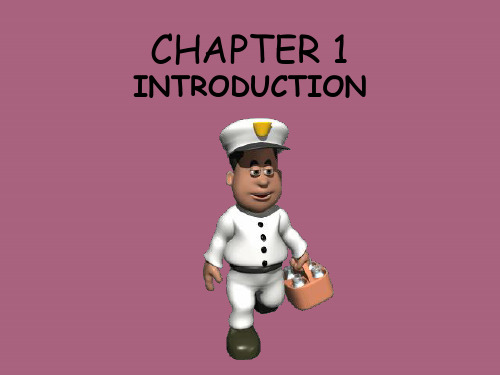
It is also possible to create value through shared interests and through scale (task too big for one party to accomplish alone)
The other potential consequence of interdependent relationships is conflict
Value Creation
Synergy: the notion the "the whole is greater than the sum of its parts".
Five Major Strategies for Conflict Management:
4 Problem solving Actors show high concern in obtaining
own outcomes, as well as high concern for the other party obtaining their outcomes 5 Compromising Actors show moderate concern in obtaining own outcomes, as well as moderate concern for the other party obtaining their outcomes
The Dual Concerns Model
The Sandtraps of Negotiation
国际商务谈判英文课件
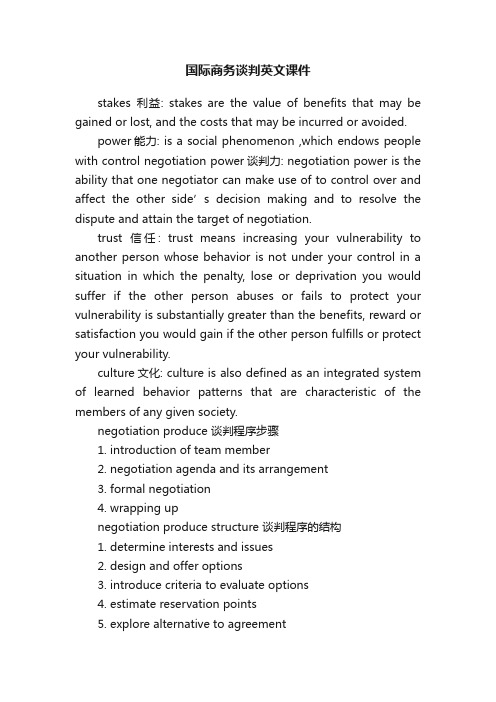
国际商务谈判英文课件stakes利益: stakes are the value of benefits that may be gained or lost, and the costs that may be incurred or avoided.power能力: is a social phenomenon ,which endows people with control negotiation power谈判力: negotiation power is the ability that one negotiator can make use of to control over and affect the other side’s decision making and to resolve the dispute and attain the target of negotiation.trust信任: trust means increasing your vulnerability to another person whose behavior is not under your control in a situation in which the penalty, lose or deprivation you would suffer if the other person abuses or fails to protect your vulnerability is substantially greater than the benefits, reward or satisfaction you would gain if the other person fulfills or protect your vulnerability.culture文化: culture is also defined as an integrated system of learned behavior patterns that are characteristic of the members of any given society.negotiation produce 谈判程序步骤1. introduction of team member2. negotiation agenda and its arrangement3. formal negotiation4. wrapping upnegotiation produce structure 谈判程序的结构1. determine interests and issues2. design and offer options3. introduce criteria to evaluate options4. estimate reservation points5. explore alternative to agreement6. reach an agreementstructure of business negotiation 贸易谈判的机构inquiry---offer---counteroffer—acceptancetarget level谈判三种目标1. desirable target :is what negotiations wish to attain but in reality ralely reach2. acceptable target :is what negotiation make all efforts to achieve3. bottom target :is what negotiations will defend and safeguard whichall their efforts信息的直接用途:problem solving信息的间接用途:strategic planningwhere to collect information信息的收集渠道1. international organization2. governments3. service organization4. directories and newsletters5. online servicefour cause of unwilling?不愿意做谈判准备的原因?1. lack of sensitivity2. limited cognition3. lack of familiarty4. inactivity and gambling mindfour steps 谈判准备的步骤?1. target decision2. collecting information3. staffing negotiation teams4. choice of negotiation venueswhen is the third party desired?什么时候选择第三方加入谈判?1. power is relatively lower than other counterpart3. negotiation goes impasse and no alternative available4. established norms and standards hinder the processwhen to choose third party’s venue(何时选择第三方谈判地点):1) first, the two negotiating parties are hostile and antagonistic to each other, or even engaged in a fighting against each other.2) second, negotiation goes into an impasse and no sign of rapprochement, impossible to carry on negotiation in neither party’s place.3) third, a dispute is stirred up when both parties strongly demand to host the negotiation.win-win model 双赢模式1. determine each party’s own interest and needs2. find out the other party’s interests and demands3. discuss the possibilities of making concessionwin—lose model 输赢模式1. determine each party’s own interests and stance2. defend one’s own interests and stance3. discuss the possibilities of making concession1.people: separate the people from problem2.interests: focus on interests but not positions3.gaining: invent options for mutual gain4.criteria: introduce objective criteriahow to tell a criterion is objective 如何客观品评判标准1. independent of wills and free from sentimental influence2. valid and realistic3. at least theoretically accepted by both sideshow to standards for successful negotiation判定谈判成功与否的标准1. satisfy the both valid interests, resolve the conflicts, protect interests2. highly efficient3. improve the relationshipneeds theory 需求理论五种1. physiological needs2. safety needs3. love and belonging needs4. esteem needs5. needs to for self-actualization6. needs to know and understand7. aesthetic needslaw of two level game 双层法规level 1 international level :relationship of interests and chances of success of negotiationno changesuccess possiblesuccess increasinglevel 2 domestic level :win—sets, the sets gain the necessary majority among the constituentsconclusion:the larger win—sets make the more likely an agreement at level 1the smaller win—sets can be a bargaining advantage for a country at level 哪些因素影响谈判力:1. motivation: a party’s power is increasing with decreasing of itsmotivation or the greater a party’s motivation is ,the weaker its relative.2. dependence: a party’s power is diminishing with increasing of itsdependence on the other party3. substitutes: one party’s indepen dence increase and thus its power isstrengthened when there are more substitutes available for considerationhow to stimulate motivation(如何刺激对方的动机):1.offering inducements2.demonstrating attractiveness3.getting external third party back4.placing a time limithow to increase substitutes(如何增加拟方替代):1.has alternatives which allow operating without the other party2.absorb the escalating cost of conflict3.can continue despite the other party’s discouraging effects on itssupportersdeterminants affecting a person’s trustful or mistrustful behavior(影响人的信任或不信任行为的决定因素):1. unchangeable elements: 1) childhood education; 2) professional or special trainingeffect or trust 信任的效应结论trust stimulates intellevtual development and originality, and leads to greater emotional stability and self-control. trust facilitates accepts and open of expression for establishing sound relationship among negotiating team members as well as between negotiating parties. negotiations based conversely, mistrust provokes rejection and defensireness, damages vollaboration in a group with wish high level of mistrust, members signal of mistrust and expect mistrust from others, thusproduce law level of trust.ac model:2. collaborating: sharing information & understanding; enlict finding a creative solution; cooperation; during4. avoiding: skipping meetings; avoid people; withholding information; delaying结论:the more stakes and power, the more assertiveness depends on alignment of interest and relationship; the more mutual interests and the more mutual trust, the more cooperativeness一次囚徒和多次囚徒的结论--one-short prison’s dilemma game rarely leads to cooperation--iterated prison’s dilemma games lead to cooperation and high trust 两分法分类:reward system; relationship; tangible issues; assumptions; strategy usedhow to build a coalition(怎样建立谈判联盟):1.setting coalition targets:(1) parties who can join;篇二:英文版商务谈判a是中国的卖方,b美国买方;咱们组是a公司成员leader(l):shi 主谈marketing(m):zhao lawyer(la):ruanfinancial(f):时technicist(t):金显而易见,我们就是b公司成员:gm:卢(andy)marketing executive:小花legal adviser:孙financial advisor:王大花professional: 康师傅卢: thank you for your warm reception. it will be excited if we can get a satisfactory result . ok, we would like to get the ball rolling(开始)by talking about prices.m: shoot.(洗耳恭听)id be happy to answer any questions you may have. 曌: your products are very good. but im a littleworried about the prices youre offering. m: you think we about be asking for more?曌: thats not exactly what i had in mind. i know your research costs are high, but what id like is a 25% discount.m: that seems to be a little high, miss. sweet. i dont know how we can make a profit with those numbers.曌: well, if we promise future business-volume sales(大笔交易)-that will slash your costs(大量减低成本)for making the products, right?m: yes, but its hard to see how you can place such large orders. wed need a guarantee of future business, not just a promise.曌: we said we wanted 1000 pieces over a six-month period. what if we place orders for twelve months with a guarantee?m: if you can guarantee that on paper, i think we can discuss this further. 卢: what’s about having a rest now? good rest, good spirit!ten minutes laterf: miss. sweet, we have considered you advice carefully. but even with volume sales, our coats for the products wont go down much.曌: just what are you proposing?王: thats a big change from 25! 10 is beyond my negotiating limit. any other ideas? f: i dont think i can change it right now. why dont we talk again tomorrow?王:sure. i don’t think our capital can allow we to make a deal in this price and this numbers.next daym:yeah, i hope so! and i hope we can make a concession to reach somemiddle ground.曌:i understand. we propose a structured deal(阶段式和约). for the first six months, we get a discount of 20%, and the next six months we get 15%.曌:then youll have to think of something betterm:how about 15% the first six months, and the second six months at 12%, with a guarantee of 3000 units?曌:thats a lot to sell, with very low profit margins.卢:(smiles) o.k., 17% the first six months, 14% for the second?! l:good. get it.康:how long is the quality guarantee period?t:2 years general. and we can guarantee that the quality is better.t:we can guarantee that our quality is one of the best in the world. we have the advanced research and development ability. whereas this is our first cooperation, we can extend it to 3 years.康: that’s good! thank you!la:for it is the first time for us to do business. it will be better having a good way to discover the disputes may appear between us.孙:sounds good! as the practices, we usually resolve the disputes with our partners visa arbitration.曌:wed like you to execute the first order by the 31st.m:ok, let me run through this again: the first shipment for 1000units, to be delivered in 27 days, by 31st june. the second shipment for 2000 units, to be delivered by 20 august 卢:fine , this deal promises big returns(赚大钱)for both sides. lets hope its the beginning of a long and prosperous relationship.l:yes ,through two days negotiation i argue that we havereached a win-win result and we are very pleased to cooperate with you for a long time.卢:that’s true! what’s the good time for us to sign the contract.m: as our arrangement. you would have a visit to the shaolin temple, over there you will learn the nature of chinese-kung fu. then we can sign the contract tomorrow morning!卢: wonderful! it’s can not be better more篇三:国际商务谈判课件国际商务谈判1谈判就是为达成协议,参与各方当事人通过信息交流与沟通,相互提出要求、互相让步与妥协的行为过程。
国际商务谈判 Chapter 2
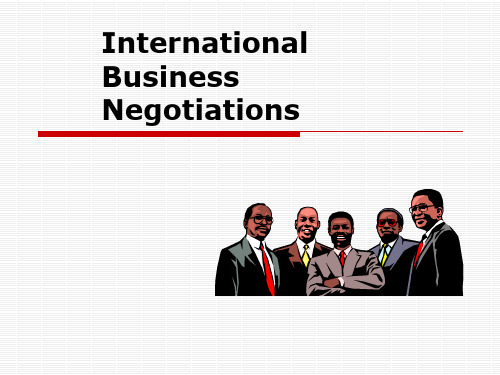
a. First hand information.
(money spending and time-consuming)
b.Second hand information.
1. International organizations a. United Nation’s Statistical Yearbook b. The World Atlas public by the World Bank c. The International Monetary Fund and The World Bank public summary economic data and occasional staff papers that evaluate issues in depth. Etc.
Preparation
Target decision Collecting information Staffing negotiation teams Choice of negotiation venues
Target decision
in addition to interest preference decision, negotiations, in view of negotiation strategy, will set at least three objective levels.
Collecting information
What is information? Information is generally esteemed as a valuable commodity in a sense that it has the power to reduce uncertainty. “the tip of be successful in negotiation is to know everyth. And to answer everyth. ”----Kissinger ( famous negotiator ) Eg. 60’s 日本竞标大庆油田设备
国际商务谈判:理论、案例分析与实践(第五版)英文版课件Chapter 2
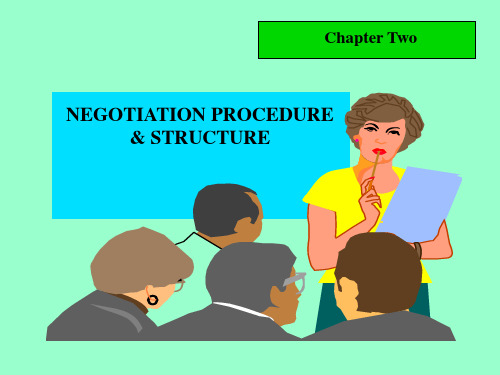
Step three: determining reservation point
Alternative 1: Value of distribution through home-based company where commission is 7% of sales: 7% × 0.5 = 3.5%
Offer
Counter offer
Acceptance
Case Study One
•Do you think the case shows the principle of mutual giving and taking during negotiation? •How important is the exploration of alternative option in this case?
Design and offer options
Reach an agreement
Explore alternatives to
agreement
Introduce criteria to evaluate option
Estimate reservation points
Байду номын сангаас
Example of how to make an
assessment of BATNA
Step one: Brainstorm alternatives Alternative 1: Distribution through a home-based company Alternative 2: Distribution on the Net Alternative 3: Increase foreign distributor’s commission to 10% Step two: Evaluate each alternative Assume the sales potential in the market is $20 million Thus, the expected value of sales is as follows: Alternative 1: $20 million ×0.5=$10 million Alternative 2: $20 million×0.2=$4 million Alternative 3: $20 million×0.3=$6 million Sales commission under the three alternatives will be: Alternative 1: $10 million × 7% = $700,000 Alternative 2: $4 million × 4% = $160,000 Alternative 3: $6 million × 10% = $600,000
- 1、下载文档前请自行甄别文档内容的完整性,平台不提供额外的编辑、内容补充、找答案等附加服务。
- 2、"仅部分预览"的文档,不可在线预览部分如存在完整性等问题,可反馈申请退款(可完整预览的文档不适用该条件!)。
- 3、如文档侵犯您的权益,请联系客服反馈,我们会尽快为您处理(人工客服工作时间:9:00-18:30)。
BATNA. • Negotiators should be willing to accept any set
of terms superior to their BATNA.
2-7
Self-Assessment: What Is My Reservation Point?
You can determine your reservation point, or the quantification of your BATNA, with respect to other alternatives by the following steps:
• In negotiation, immediate acceptance of a first offer by the counterparty often means a better outcome for the proposing negotiator, but the outcome is less satisfying.
People with this fixed-pie perception take one of three mindsets when preparing for a negotiation:
• Resign themselves to capitulating to the counterparty
• BATNA risk: given BATNAs of equal expected value, the more risk-averse negotiator will be in a weaker bargaining position
• Contractual risk: refers to the risk associated with the willingness of the other party to honor its terms
• Brainstorm your alternatives. • Evaluate and order each alternative’s value. • Attempt to improve your BATNA. • Determine your reservation price based on facts. • See Exhibit 2-1.
It is commonly assumed that concessions are necessary by one or both parties to reach an agreement. The fixed-pie perception is almost always wrong and often leads to an ineffective approach to negotiations.
2-12
Self-Assessment: Am I Going to Regret This?
An important component in determining whether a person experiences regret is counterfactual thinking, or “what might have been.”
2-1
Part One The Essentials of Negotiation
— Chapter 2 — Preparation:
What to Do Before Negotiation
2-2
The Fixed-Pie Perception
Most negotiators believe whatever is good for one party must be bad for the counterparty.
• The paradox of this situation is that no matter what happens, people choose to do the same thing (a.k.a., the sure thing principle).
• Violations of the sure thing principle are rooted in the reasons people use to make their decisions.
2-4
Mixed-Motive Decision-Making: A more effective and accurate model
A more accurate model of negotiation is to approach it as a mixed-motive decision-making enterprise involving both cooperation and competition.
2-11
Self-Assessment: Endowment Effects
Differences in negotiators’ reference points may lead buyers and sellers to have different valuations for the same object
2-8
Self-Assessment: Setting Up The Negotiation
When determining your reservation point, be aware and knowledgeable of the following:
• Be aware of focal points. • Beware of sunk costs. • Do not confuse your target point with your
2-10
Self-Assessment: Assess Your Risk Propensity
In any negotiation, negotiators should consider the differential impact of three sources of risk:
• Strategic risk: refers to the riskiness of the tactics that negotiators use at the bargaining table
• Prepare for hard bargaining with the counterparty
• Compromise in an attempt to reach a midpoint between opposing demands
2-3
The Fixed-Pie Perception
Effective preparation for a negotiation encompasses three general abilities:
• Self-assessment • Assessment of the counterparty • Assessment of the situation
• In the presence of uncertainty, people may be reluctant to think through the implications of each outcome.
2-14
Self-Assessment: Assessing Co about an event occurring, people are reluctant to make decisions and will delay decisions until the uncertain event is known.
• Overaspiring or positional negotiator • The grass-is-greener negotiator
2-6
Self-Assessment: What Is My BATNA?
What is my Best Alternative To a Negotiated Agreement in this situation (your BATNA)?
• Thinking about what might have been, but did not occur, may be a reference point for the psychological evaluation of actual outcomes.
2-13
Self-Assessment: Sure Thing Principle
2-5
Self-Assessment: What Do I Want?
Identifying what you want may sound straightforward, but three major problems often arise:
• Underaspiring negotiator (the Winner’s Curse)
• Someone who possesses an object has a reference point that reflects his or her current endowment, or private valuation, of the object.
• The difference between what sellers demand and what buyers are willing to pay is a manifestation of loss-aversion.
